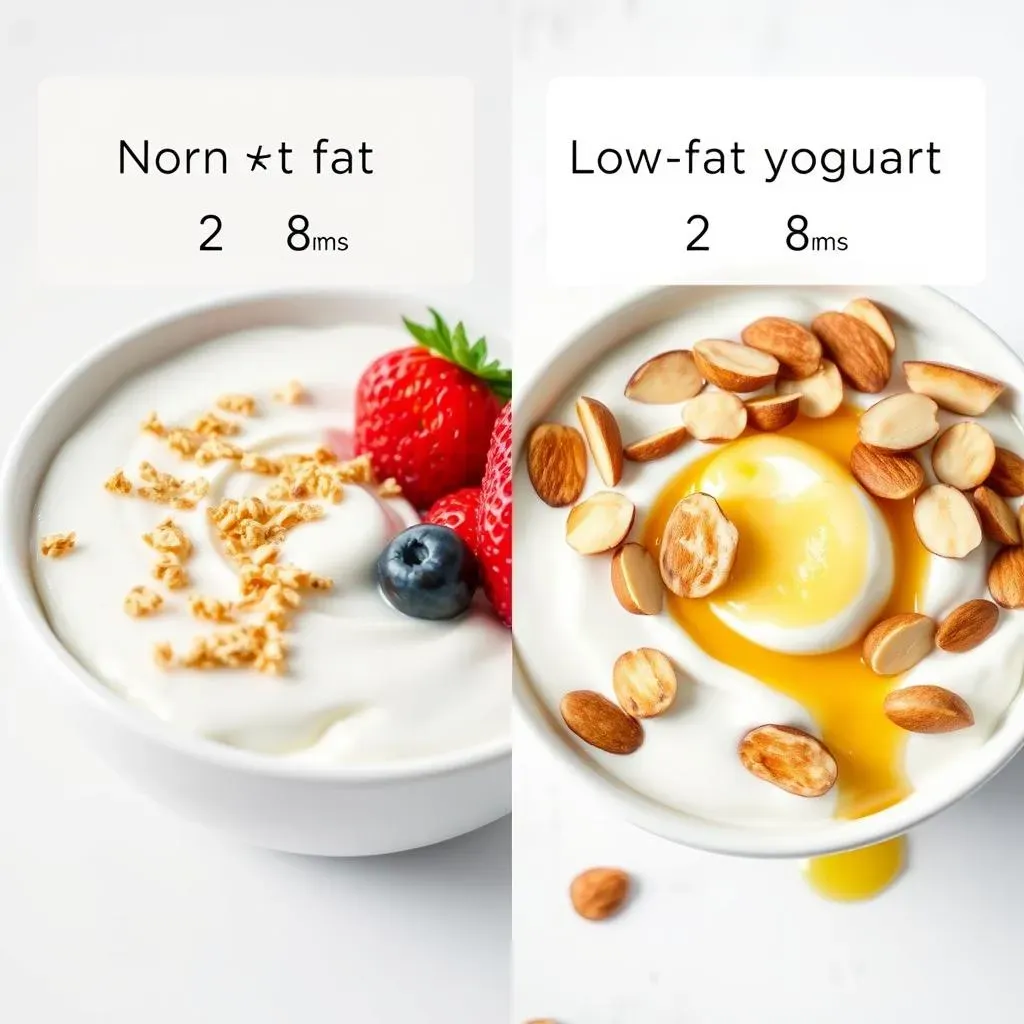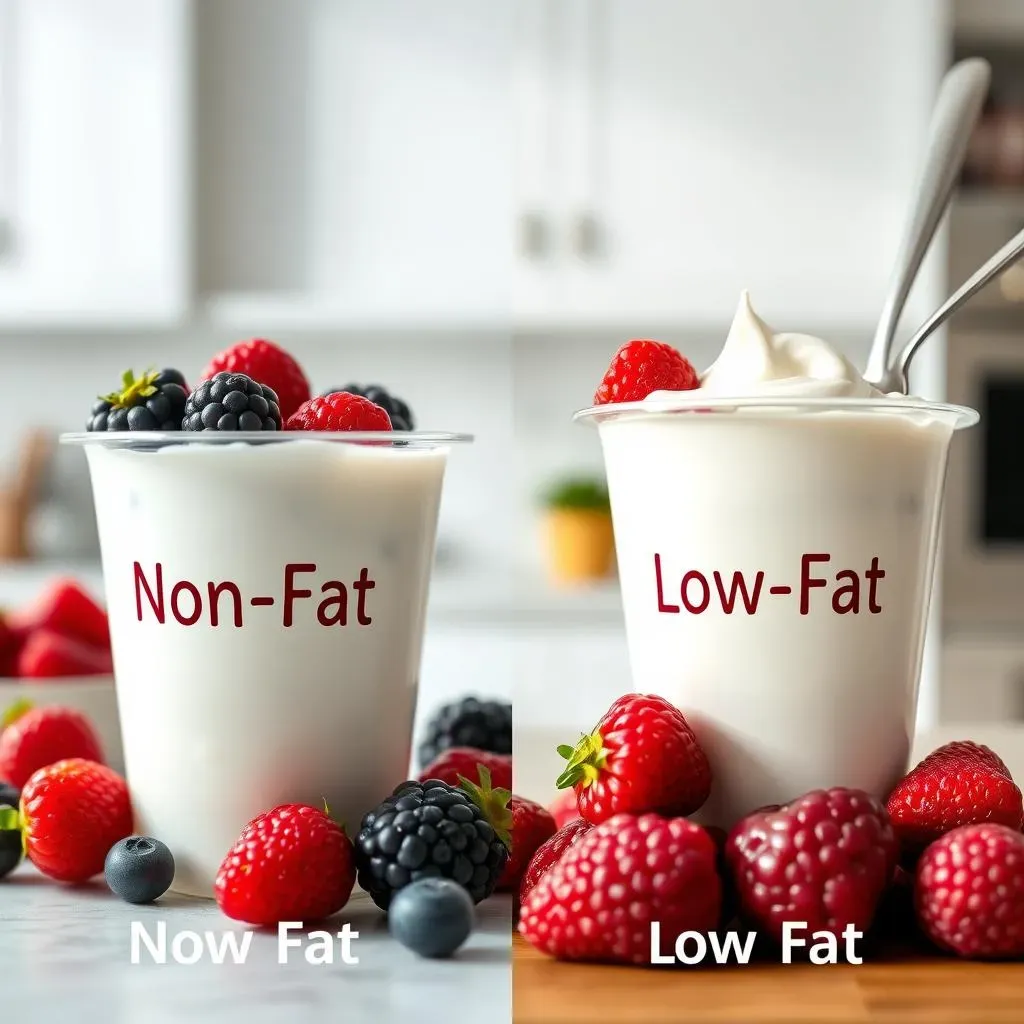Table of Contents
Walking down the yogurt aisle can feel like navigating a nutritional minefield, right? With countless brands and varieties, figuring out what's actually good for you can be a real head-scratcher. One of the most common dilemmas? Deciding between non fat vs low fat yogurt. Are you trying to cut calories? Or are you simply curious about the nutritional differences? Maybe you're wondering if the taste is even worth the swap. This article is your ultimate guide to understanding the key differences between these two popular options. We'll break down the nutritional facts, explore the potential health benefits, and help you determine which type of yogurt best aligns with your individual dietary needs and taste preferences. So, grab a spoon, and let's dive into the creamy world of yogurt!
What's the Deal with Yogurt: A Quick Overview

What's the Deal with Yogurt: A Quick Overview
The Ancient Origins of Yogurt
Yogurt isn't some newfangled health fad; it's been around for centuries! We're talking ancient civilizations in the Middle East and Asia leaving milk out to ferment – accidentally creating what we now know and love as yogurt. The fermentation process is key. It involves adding specific bacteria (those good-for-your-gut probiotics!) to milk, which then converts lactose (milk sugar) into lactic acid. This lactic acid is what gives yogurt its characteristic tangy flavor and thick texture. Pretty cool, huh?
Ever wonder how many different kinds of yogurt there are? It's not just plain or flavored! From Greek to Icelandic (Skyr), to Australian, there's a whole world of yogurt textures and tastes to explore. Each type has its own unique production method, affecting the final product's consistency, protein content, and even its tanginess. It's like the craft beer scene, but for dairy!
What Makes Yogurt So Darn Good For You?
so yogurt tastes good, but what's the big deal about its health benefits? Well, for starters, it's packed with protein, which is essential for building and repairing tissues. It's also a great source of calcium, crucial for strong bones and teeth. But the real magic lies in those probiotics we mentioned earlier. These beneficial bacteria support a healthy gut microbiome, which can improve digestion, boost your immune system, and even impact your mood! A happy gut equals a happy you, right?
But that is not it, yogurt also often contains essential vitamins and minerals like vitamin B12, potassium, and magnesium, contributing to overall well-being. Plus, some studies suggest that regular yogurt consumption may be linked to a reduced risk of certain chronic diseases. It's like a nutritional powerhouse in a cup!
Navigating the Yogurt Aisle: A Beginner's Guide
Now, let's face it: the yogurt aisle can be overwhelming. There are so many options, it's hard to know where to start. First things first: read the labels! Pay attention to the ingredients list, sugar content, and nutritional information. Look for yogurts with live and active cultures to ensure you're getting those probiotic benefits. And don't be afraid to experiment with different types and brands to find what you like best. Remember, healthy eating should be enjoyable, not a chore!
Also, consider your personal dietary needs and preferences. Are you lactose intolerant? Opt for lactose-free yogurt. Are you watching your sugar intake? Choose plain yogurt and add your own fruit or honey for sweetness. Are you looking for a protein boost? Greek yogurt is your best bet. The key is to find a yogurt that fits your lifestyle and helps you achieve your health goals. And remember, non fat vs low fat yogurt is just one piece of the puzzle!
Non Fat vs Low Fat Yogurt: Decoding the Labels and Differences

Non Fat vs Low Fat Yogurt: Decoding the Labels and Differences
Alright, let's get down to brass tacks. When you're staring at those yogurt containers, what do "non fat" and "low fat" actually mean? It's all about the milk, baby! Non fat yogurt, as the name suggests, is made with skim milk, meaning virtually all the fat has been removed. Low fat yogurt, on the other hand, is made with milk that still contains a small percentage of fat – usually around 1-2%. This difference in fat content affects not only the calorie count but also the texture and even the taste of the final product. So, before you even consider the brand or flavor, understanding this basic distinction is key.
Now, let's break it down with a handy table. This will make it super clear what you're getting with each type of yogurt:
Yogurt Type | Fat Content | Milk Used | Typical Calorie Count (per 6oz serving) |
|---|---|---|---|
Non Fat | Less than 0.5g | Skim Milk | Around 80-120 |
Low Fat | 1-2g | 1% or 2% Milk | Around 100-150 |
But here's a little secret: sometimes, to compensate for the lack of fat in non fat yogurt, manufacturers add thickeners or sweeteners to improve the texture and flavor. That's why it's super important to read the ingredient list! You might be surprised to find added sugars, artificial flavors, or other additives you weren't expecting. The goal is to find a yogurt that's both low in fat and made with simple, wholesome ingredients. It's like finding a unicorn, but trust me, they're out there!
Nutritional Showdown: Comparing Non Fat and Low Fat Yogurt Benefits

Nutritional Showdown: Comparing Non Fat and Low Fat Yogurt Benefits
Alright, let's get into the nitty-gritty of what each type of yogurt brings to the table, nutritionally speaking. Both non fat and low fat yogurt are excellent sources of protein, calcium, and essential vitamins. However, the key differences lie in their fat and calorie content. Non fat yogurt generally has fewer calories and, of course, significantly less fat than its low fat counterpart. This can be a major advantage if you're watching your weight or trying to reduce your overall fat intake. On the other hand, the small amount of fat in low fat yogurt can contribute to a feeling of fullness and satisfaction, which might help you avoid overeating later on. It's all about finding the right balance for your individual needs and goals!
To give you a clearer picture, let's compare the typical nutritional profiles of non fat and low fat yogurt (per 6-ounce serving):
Nutrient | Non Fat Yogurt (approximate) | Low Fat Yogurt (approximate) |
|---|---|---|
Calories | 80-120 | 100-150 |
Total Fat | 0-0.5g | 1-2g |
Protein | 15-20g | 15-20g |
Calcium | 15-20% DV | 15-20% DV |
Sugar | Varies (check label) | Varies (check label) |
Now, here's where things get interesting. While non fat yogurt may seem like the obvious choice for weight loss, it's important to consider the bigger picture. Some studies suggest that consuming full-fat dairy products (which are similar to low-fat options in terms of overall fat content) may actually be associated with a lower risk of obesity and type 2 diabetes. This could be because the fat helps you feel fuller for longer, leading to reduced calorie intake throughout the day. Of course, more research is needed to fully understand this relationship, but it's definitely something to keep in mind. Ultimately, the best choice for you depends on your individual circumstances and preferences. It's all about making informed decisions and finding what works best for your body!
Making the Right Choice: Which Yogurt Fits Your Diet Goals?

Making the Right Choice: Which Yogurt Fits Your Diet Goals?
so we've covered the basics, the nutritional stats, and even some surprising research. Now comes the million-dollar question: which yogurt should you actually choose? The answer, my friend, is it depends! It hinges entirely on your personal diet goals and overall lifestyle. Are you laser-focused on weight loss? Are you trying to manage a specific health condition? Or are you simply looking for a healthy and delicious snack? Let's break down some common scenarios and see which yogurt comes out on top.
If weight loss is your primary goal, non fat yogurt might seem like the obvious choice. With its lower calorie and fat content, it can be a great way to reduce your overall calorie intake. However, remember that feeling of fullness we talked about? If you find that non fat yogurt leaves you feeling hungry and unsatisfied, you might end up overeating later on. In that case, low fat yogurt could be a better option, as the small amount of fat can help you stay satiated for longer. It's all about finding what works best for your body and helps you stick to your calorie goals. Also, be mindful of added sugars in flavored non fat yogurts! Opt for plain varieties and add your own fruit or a drizzle of honey for sweetness.
Now, what if you're not necessarily trying to lose weight, but rather maintain a healthy lifestyle? In that case, both non fat and low fat yogurt can be excellent choices. The key is to focus on the overall nutritional profile and choose yogurts that are low in added sugars and made with wholesome ingredients. Look for yogurts with live and active cultures to support a healthy gut, and be sure to incorporate a variety of other nutrient-rich foods into your diet as well. Remember, yogurt is just one piece of the puzzle! It's all about creating a balanced and sustainable eating plan that you can enjoy for the long haul.
Here's a quick guide to help you decide:
- Weight Loss: Non fat yogurt (plain, with added fruit) or low fat yogurt (if it helps with satiety).
- Weight Maintenance: Both non fat and low fat yogurt (focus on low added sugar and wholesome ingredients).
- Muscle Building: Greek yogurt (both non fat and low fat) for a high protein boost.
- Digestive Health: Yogurt with live and active cultures (both non fat and low fat).
Beyond the Basics: Exploring Yogurt Varieties and Serving Ideas

Beyond the Basics: Exploring Yogurt Varieties and Serving Ideas
Beyond the Plain Cup: A World of Yogurt Awaits
So, you've mastered the art of choosing between non fat and low fat yogurt – congrats! But the yogurt adventure doesn't stop there. Did you know there's a whole universe of yogurt varieties waiting to be explored? From the tangy thickness of Greek yogurt to the creamy smoothness of Australian yogurt, each type offers a unique taste and texture experience. And let's not forget about Icelandic Skyr, known for its incredibly high protein content. Branching out beyond your usual go-to can not only add excitement to your snacking routine but also introduce you to new nutritional benefits. It's like a culinary passport for your taste buds!
Consider trying yogurt made from different types of milk, too! Goat milk yogurt offers a slightly different flavor profile and can be easier to digest for some people. Plant-based yogurts, made from almond, soy, or coconut milk, are excellent options for vegans or those with dairy sensitivities. Each variety brings its own unique set of nutrients and flavors to the table. The possibilities are endless!
Level Up Your Yogurt Game: Creative Serving Suggestions
so you've got your yogurt of choice – now what? Eating it straight from the container is perfectly fine, but why not get a little creative? Yogurt can be so much more than just a snack! It's a versatile ingredient that can be used in a variety of dishes, from breakfast parfaits to savory sauces. Think about layering yogurt with granola and berries for a quick and healthy breakfast. Or, use it as a base for a creamy and flavorful dip for veggies or chips. You can even add it to smoothies for a protein boost and a tangy twist.
Want to get even more adventurous? Try using yogurt as a marinade for chicken or fish – the lactic acid helps tenderize the meat and adds a delicious flavor. Or, use it to make a light and refreshing tzatziki sauce for gyros or grilled vegetables. And for a sweet treat, try freezing yogurt in popsicle molds with fruit and honey for a healthy and delicious dessert. The only limit is your imagination! So, ditch the boring routine and start exploring the endless possibilities of yogurt.
Here are some serving ideas to get you started:
- Breakfast Parfait: Layer yogurt with granola, berries, and a drizzle of honey.
- Smoothie Booster: Add a scoop of yogurt to your favorite smoothie recipe for extra protein and creaminess.
- Savory Dip: Mix yogurt with herbs, spices, and lemon juice for a healthy and flavorful dip.
- Marinade Magic: Use yogurt as a marinade for chicken, fish, or vegetables.
- Frozen Treat: Freeze yogurt in popsicle molds with fruit and honey for a healthy dessert.
The Final Scoop on Non Fat vs Low Fat Yogurt
Ultimately, the choice between non fat and low fat yogurt boils down to your personal preferences and dietary goals. There's no definitive "winner" in the non fat vs low fat yogurt debate. If you're strictly watching calories, non fat yogurt might be your go-to. However, if you prefer a richer taste and don't mind the extra fat, low fat yogurt can be a satisfying and nutritious option. Regardless of which you choose, remember to check the label for added sugars and prioritize options with live and active cultures for optimal gut health. So go ahead, experiment with different brands and flavors, and find the yogurt that makes both your taste buds and your body happy!
